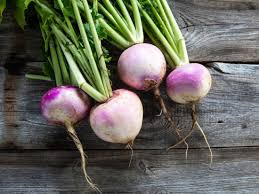Health Benefits of Turnips
When was the last time you craved a turnip? Never? Fair enough. In comparison to its cousins — kale, cauliflower, arugula, and cabbage — the turnip isn’t a regular on most menus. But it’s got a health profile that makes it worth checking out.
Turnips are among the oldest and hardiest vegetables. They grew wild in Siberia when dinosaurs roamed the earth and got an early reputation as a food for poor people and farm animals.
Today, many people wouldn’t know a turnip if they saw or tasted one. People mistake it most often for the rutabaga, which is a cross between a turnip and cabbage.
So here’s your turnip 101: It’s a root vegetable in the Brassicacae family of mustard plants. It’s ready for harvest in the spring and fall. The most common turnip is light purple on top and white on the bottom, but there are more than 30 kinds with varying shapes and colors. Some are sweet, like a carrot, while others taste more like a potato.
Calories: 34
Fat: 0.1 gram of fat
Carbs: 7 grams
Protein: 1 gram
Fiber: 2 grams
Sugar: 4 grams
Cholesterol: 0 grams
Turnips are full of vitamins and minerals like:
Fat: 0.1 gram of fat
Carbs: 7 grams
Protein: 1 gram
Fiber: 2 grams
Sugar: 4 grams
Cholesterol: 0 grams
Turnips are full of vitamins and minerals like:
Calcium
Folate
Magnesium
Phosphorus
Potassium
Vitamin C
Turnip greens load you up with vitamins A and C. One cup of raw turnip greens has 6,373 international units (IU) of vitamin A and 33 milligrams (mg) of vitamin C.
Folate
Magnesium
Phosphorus
Potassium
Vitamin C
Turnip greens load you up with vitamins A and C. One cup of raw turnip greens has 6,373 international units (IU) of vitamin A and 33 milligrams (mg) of vitamin C.
Health Benefits
One medium turnip has 233 mg of potassium. Your body needs that mineral for just about everything, including helping your nerves send signals and keeping your muscles and heart in good working shape. When you don’t get enough, you’re at risk for high blood pressure, stroke, kidney stones, brittle bones, and high blood sugar.
One medium turnip has 233 mg of potassium. Your body needs that mineral for just about everything, including helping your nerves send signals and keeping your muscles and heart in good working shape. When you don’t get enough, you’re at risk for high blood pressure, stroke, kidney stones, brittle bones, and high blood sugar.
Turnips have plenty of other benefits, too.
Cancer prevention. Turnips have glucosinolates — plant-based chemicals that may help prevent all kinds of cancer, from breast to prostate.
Eye health. Turnips are rich in the antioxidant lutein. This keeps your eyes healthy and wards off problems like macular degeneration and cataracts.
Bone health. Dairy isn’t the only way to build strong bones and stay one step ahead of the bone-weakening disease osteoporosis. Turnips have a significant amount of calcium, which also helps your heart, muscles, and nerves.
Risks and Warnings
Some health problems and medications don’t mix well with turnips. Talk to your doctor if:
Some health problems and medications don’t mix well with turnips. Talk to your doctor if:
You need a fecal occult blood test. Turnips, broccoli, and some other fruits and vegetables may give you a false positive or false negative on this test, which looks for hidden blood in your stool.
Your blood clots too quickly. If you have certain conditions, too many turnip greens — which are high in vitamin K — can cause your blood to clot faster than normal.
You have a kidney condition. Your kidneys remove extra potassium from your body. If they don’t work well, you may have too much potassium in your system. This causes a rapid heartbeat and muscle issues like weakness, cramps, or stiffness.
How to Prepare Turnips
A good turnip is a small turnip. The big ones tend to be bitter. Look for turnips that feel firm and don’t have any spots.
A good turnip is a small turnip. The big ones tend to be bitter. Look for turnips that feel firm and don’t have any spots.
At home, cut off the root and base of the leaves. Don’t wash it until you’re ready to eat. They’ll keep in the refrigerator up to a week.
Peel the skin unless it’s a baby turnip.
Raw or cooked, turnips are incredibly versatile:
Boil or steam turnips and add them to mashed potatoes for extra vitamins and minerals.
Grate them raw into salads or slaws.
Roast them with other root vegetables like carrots and sweet potatoes, and bring out their natural sweetness.
Swap turnip greens for spinach or collards and sauté them with garlic, olive oil, and lemon.
Pickle turnips and their greens to get gut-friendly probiotics.
Grate them raw into salads or slaws.
Roast them with other root vegetables like carrots and sweet potatoes, and bring out their natural sweetness.
Swap turnip greens for spinach or collards and sauté them with garlic, olive oil, and lemon.
Pickle turnips and their greens to get gut-friendly probiotics.

Comments
Post a Comment